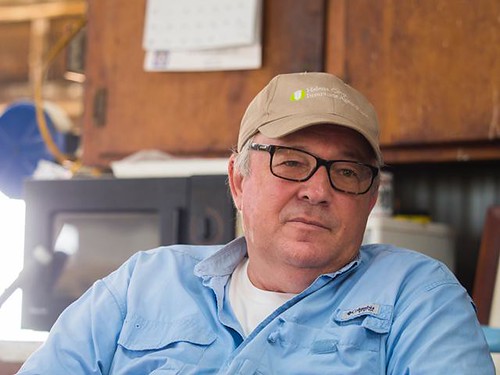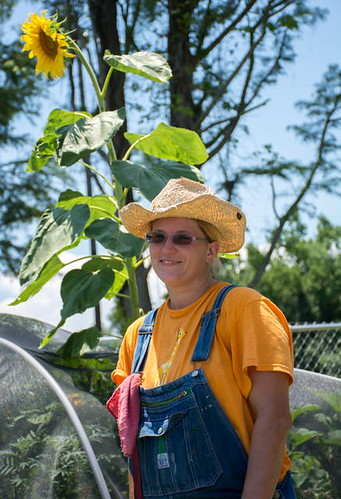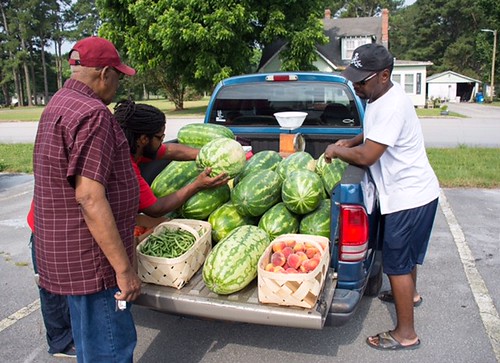
“He would often dream up new ideas and inventions that he would build in his shop and implement on his farm. Most all of them worked better than anything else available. He never faced a hill that he didn’t think could be flattened with a lot of hard work and determination, and he taught those around him to question the conventional wisdom and not be afraid to boldly seek new ways of doing things.” - from Leroy Isbell’s obituary in the Stuttgart Daily Leader, 2014

Chris Isbell didn't set out to make history. He was just following in his father's footsteps.
But on June 14, 2017, Chris Isbell and six other farmers - two from California and five from Arkansas and Mississippi - did just that. The first ever carbon credits generated from rice farmers were sold to Microsoft, all because these pioneers tested out a radical idea – that by implementing conservation practices on their crops, rice farmers could reduce methane emissions and thereby generate a carbon credit that could later be sold on the carbon market. Their voluntary conservation practices not only generated carbon credits but also reduced energy consumption and water use, critical to both regions.
The sale of the carbon offset credits, managed by Terra Global Capital, to Natural Capital Partners on behalf of its client Microsoft, rewards the farmers for their activities and demonstrates credibly measured environmental benefits. “Being the first of a kind emission reductions from sustainable rice production, Microsoft valued the innovation by farmers and the investment in technology to catalyze measuring and monitoring emission reductions,” said Rob Bernard, Chief Environmental Strategist, Microsoft.
A diverse group of like-minded partners guided the farmers through the process, including Terra Global Capital, American Carbon Registry, USDA Natural Resources Conservation Service, California Rice Commission, White River Irrigation District and the Environmental Defense Fund. This public private partnership was funded by NRCS under the Conservation Innovation Grants program and Entergy Corporation, an integrated energy company, through its Environmental Initiatives Fund.
“The Conservation Innovation Grant program is an example of government at its best, providing seed money to help spur cutting-edge projects,” said NRCS Acting Chief Leonard Jordan.
NRCS recently published an interactive story about the project and four of the rice farmers, together called Nature’s Stewards.
With this project success in sight, the NRCS awarded its newest round of competitive, national CIG awards on June 8, 2017. In 2017, the NRCS will invest more than $22.6 million in 33 CIG projects nationwide, and grantees will leverage the federal investment by at least matching it.
The 2017 CIG projects focus on conservation finance and pay-for-success models to stimulate conservation adoption; data analytics for natural resources; water management technologies and approaches; and historically underserved farmers, ranchers and private forest landowners.
NRCS awarded two of the 2017 Conservation Innovation Grants to The Conservation Fund – a national organization that strives to create solutions that make environmental and economic sense. With these grants for conservation finance and economic development, The Conservation Fund will drive innovation in agricultural conservation for historically underserved, military veteran and other farmers.

“These innovative projects will help conservation work for people, communities and landscapes by encouraging strong local economies, healthy food systems and social and environmental justice,” said Larry Selzer, The Conservation Fund’s President & CEO. “By utilizing expertise in conservation finance, agricultural conservation, land acquisition, community development and small business support, we hope these projects will serve as models for reimagining local food systems and empowering historically underserved, new, young, veteran and other producers to access land and agricultural resources and achieve economic vitality.”

Project 1: Equitable Access for Sustained Productivity (Florida, Georgia, North Carolina, South Carolina, South Dakota and West Virginia)
The Equitable Access for Sustained Productivity project will address three traditional barriers for historically underserved and veteran farmers and ranchers—lack of access to capital, agricultural business training, and sustainable agriculture methods—to improve the ability of these communities to make a living in agriculture.
Project 2: Pathways for Producers in the Metro Atlanta Region: Unlocking Capital and Resources to Conserve and Transform Local Food Systems (23-county region surrounding Atlanta, Georgia)
The Conservation Fund will create an Agriculture Conservation Fund with an initial target of $5 million in impact capital to accelerate the pace of working lands conservation in 23-county region surrounding Atlanta. This innovative approach will preserve metro Atlanta’s working farmlands while increasing technical and financial resources to support producers and local food production. The ACF can serve as a model for similar efforts in metro areas around the nation.
“The CIG conservation finance and pay-for-success projects reward farmers, ranchers and producers who make their livelihoods on America’s working lands sustainably, through sound science and conservation principles,” said Acting Chief Jordan. “And CIG funding ensures that all producers, including new and under-represented farmers and ranchers, can benefit economically from innovative conservation tools and strategies.”
The 2017 CIG awards bring the total NRCS investment to nearly $286.7 million for 711 projects since 2004. Learn more about the CIG program and view the 2017 CIG project list on the NRCS website.
View an interactive map of the projects through the following link: http://arcg.is/2qduOym

